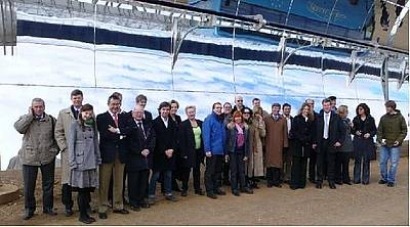
IEA member country ministers are meeting in Paris (France) today and tomorrow and will be joined by the CEOs of the world's leading energy companies to discuss the state of energy development globally, and the key issues of energy security and sustainable energy production. These deliberations come ahead of the critical COP17 Climate Change talks in Durban (South Africa) between 28 November and 9 December. Taking advantage of the spotlight on the talks in Paris, the leading solar thermal electricity associations, ESTELA (Europe), AUSTELA (Australia) and SASTELA (South Africa) have announced the founding of STELAWorld – the World Solar Thermal Electricity Association.
STELAWorld will work with international agencies such as the IEA, the UNFCCC, UN Development Program, the World Bank, the International Monetary Fund, and the European, Asian and African Development Banks “to assist policy-makers and energy investors to access information on solar thermal electricity development, and the value and rapidly reducing cost of solar thermal electricity production”.
Solar thermal electricity bodies in the United States, Spain, India, MENA region and Asia will also be approached to join the new international body. Organisations in the US and Spain have already indicated support for the initiative.
In November, the IEA will release new analysis showing that solar power can provide more than half the world's energy by 2060 and STELAWorld is encouraging IEA member country ministers to commit to accelerate moves towards a sustainable energy system based on solar resources, fostering innovation and knowledge transfer, and implementing measures to accelerate large-scale solar thermal electricity development to prevent energy scarcity and to break the link between economic development and fossil fuels.
Tremendously important
"Solar thermal electricity generation is tremendously important to the development of the global economy in the low-carbon world ahead," said Mr. Pancho Ndebele, Chairman of SASTELA. "It is the most versatile form of renewable energy available to the world, providing secure, 100% carbon-free solar power that can be stored and released when it is most needed. It can underpin job creation, industrialisation and localisation in many of the world's poorest and most populous regions."
"Solar thermal power helps our electricity systems integrate greater amounts of other, more intermittent renewable energy, such as wind and photovoltaic power, by being able to store energy and release it as electricity when it is most valuable," said Dr. Luis Crespo, President of ESTELA. "Solar thermal electricity can greatly reduce, and over time eliminate, the need for fossil fuel back-up for intermittent renewables."
Solar thermal electricity generation uses the sun's heat to make steam to drive traditional turbines and generators - steam generation technology that has been used for over 100 years, but with a clean, carbon-free solar power source. The technology has been in operation at utility scale in the United States for over 25 years, and is rapidly expanding in Europe and internationally.
100% supply certainty
"Solar thermal is unique in its range of applications and in the high local content and employment it generates," said Dr. Luis Crespo. "It can be hybridized with biomass, gas and other fuel sources to provide 100% supply certainty," said Mr. Andrew James Want, Chairman of AUSTELA.
"Even in regions without ideal solar conditions, like the UK and Northern Europe, new electricity transmission technologies will allow solar thermal electricity to be imported from sun-rich countries like Spain and Morocco, providing truly renewable, low-carbon energy security."
"This makes it a technology with huge application around the world, and a vital element in the transition from fossil fuels to renewable power," said Mr. Pancho Ndebele.
Through its member bodies, STELAWorld aims to promote data and information exchange from industry, research agencies, academic institutions and government bodies around the world relating to solar thermal power generation.
[Photo: Courtesy of ESTELA. Members of EU Paliament visit a solar thermal electricity plant]
For additional information:

